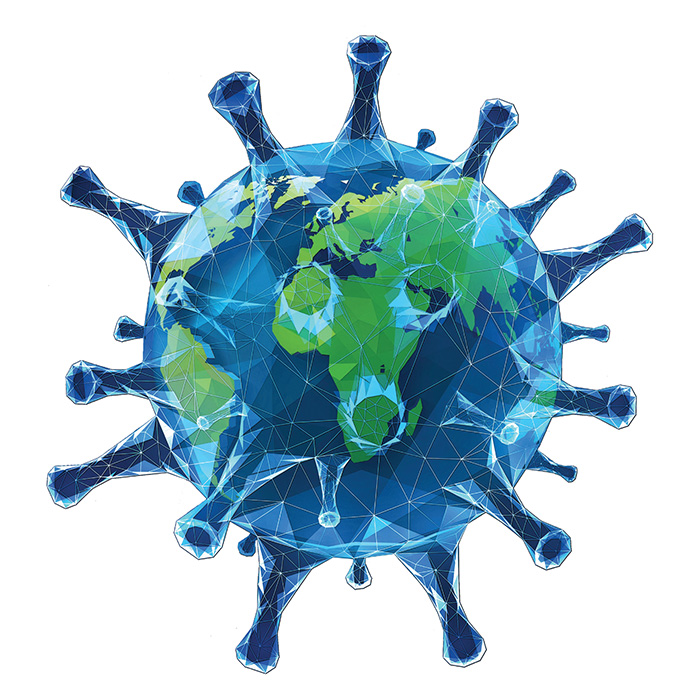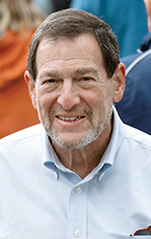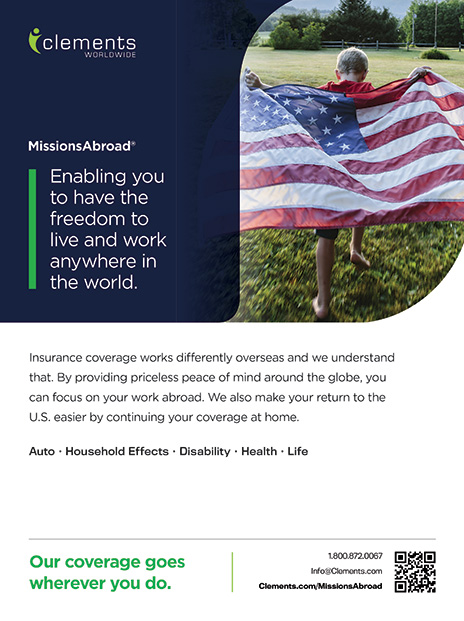COVID-19 and Global Health Governance
A career FSO with extensive experience in global health diplomacy discusses the practical problems—all solvable—in bringing the current and future health crises under control.
BY JIMMY KOLKER

istockphoto.com / Sergio Lacueva
Controlling the spread of infectious diseases requires multilateral cooperation. The objective of the first International Sanitary Conference in Paris in 1851 was to reduce to a safe minimum the conflicting and costly maritime quarantine requirements of different nations. Possibly the first binding international convention of the modern era addressed cholera. It came into force in Venice in 1892.
At the same time, health systems and health care have always been, and remain, national (and, in many cases, subnational) responsibilities. The novel coronavirus—SARS-CoV-2—has highlighted this dichotomy. Countries have taken widely different approaches to preventing and treating the spread of the disease it causes, COVID-19, while the U.S. administration publicly blamed the United Nations agency responsible for global health, the World Health Organization, for failing to provide timely and accurate information on COVID-19 and abetting China in covering up key developments.
Every pandemic is different, and the new coronavirus crisis is unprecedented in many ways—not least in the speed and intensity of the virus’ transmission around the entire world and, as a result, its exposure of weaknesses in leadership and institutional structures at the international and national level everywhere. But lapses notwithstanding, a multilateral approach remains fundamental in meeting the current challenges. It is essential that the United States engage diplomatically at a senior level in global health governance, decision-making and emergency response.
In the following, I discuss some of the problems we face and suggest practical solutions.
The WHO We Have Is Not the WHO We Need
The World Health Organization was the first technical agency established under the United Nations in the late 1940s. It is an awkward creature of its time, governed by an annual weeklong assembly of member states on the basis of presumed consensus around a rules-based, science-based world order. Because of the prowess of our biomedical research and epidemic surveillance, as well as our world standing, the United States has historically been WHO’s most influential member, and its global accomplishments, such as the eradication of smallpox in 1980, have been significant.
But COVID-19 demonstrated that WHO’s strengths are also its weaknesses. Requiring an implicit consensus to act, decision-making processes can be slow and deferential to member-state sensibilities. Its mandate to address all aspects of worldwide health and well-being is limitless, but the organization’s budget of under $4 billion per year is a tiny fraction of what bilateral donors such as the United States or major new players such as the Bill and Melinda Gates Foundation spend on global health. By comparison, the annual outlay of the Maryland state Department of Health is three times larger than WHO’s annual budget. The organization’s main roles are, therefore, to set norms and provide technical assistance to governments, not deliver health programs or clinical care itself.
The United States took a leading role in revision of WHO’s International Health Regulations in 2005. Politically binding, but without enforcement authority, the IHR require member states to “detect, assess and report on” outbreaks that might endanger international health. Dozens of such reports are submitted to and evaluated by the WHO Health Emergencies program (WHE) every year and, in rare instances, referred to expert committees to determine if they should be declared “Public Health Emergencies of International Concern.” On Jan. 30 this year, the novel coronavirus was so designated, with recommendations for action by China and other states and actors.
WHO leadership undertook important reforms following the 2014-2015 Ebola epidemic in West Africa, in which the organization initially performed poorly. They strengthened the WHE, merging two WHO divisions under a deputy director general. The deputy director general, in turn, is informed by an Independent Oversight and Advisory Committee (to give WHE more efficient governance and reporting) and a Global Preparedness Monitoring Board. The latter issued a prescient report in 2019, highlighting actions that political leaders, national governments and the U.N. system should take to prepare for a pandemic.
The WHE performed well over the past four years in confronting Zika, yellow fever and the Ebola outbreaks in the Democratic Republic of the Congo. It remains dependent, however, on emergency funding appeals, which for COVID-19 have been insufficient. And, as we saw in China, its ability to investigate or act outside restrictions set by national governments is limited.
Vaccines, Treatments and Equity
The COVID-19 pandemic makes clear what the Global Preparedness Monitoring Board pointed out—current international structures for global health lack incentives for member states to take early action, rationalize supply chains for necessary tests, coordinate development of vaccines and treatments or, in particular, adjudicate or regulate how poor people and poor countries might gain equitable access to them.
China, the United States and several other countries and consortia launched crash programs to develop coronavirus vaccines and COVID-19 countermeasures. Unlike all other recent epidemics, the entire populations of rich countries are at risk, and thus the market for these vaccines and countermeasures would be huge, immediate and lucrative. The competition to develop safe and effective vaccines or cures was spurred by governments wanting priority access to these products for their own populations, and by corporations and laboratories that could profit enormously by being first to offer an approved vaccine.
Without some sort of agreement or formula, there are formidable obstacles to scaling up vaccine use around the world.
Issues of equity arose immediately. There is no “World Vaccine Development and Distribution Agency.” No international mechanism has existing authority or the practical ability to take control of a product shown to work, equitably determine which countries or populations (e.g., health care workers) would derive maximum benefit from being treated first, or determine the price or conditions under which the product would be made available.
But there are some principles that might influence these decisions or agreements. WHO convened a conference in April to develop an “Access to COVID-19 Tools Accelerator” agreement—a global collaboration to accelerate the development, production and equitable access to new diagnostics, therapeutics and vaccines—and the European Commission and United Kingdom co-chaired a follow-on conference in May to raise billions of dollars to implement it. Governments, such as the European Union, and nongovernmental sources, such as the Gates Foundation, pledged to fund a mechanism, possibly a pooled purchasing agreement, to, they hope, guarantee that when a vaccine or cure is developed, there will be global access to it based on need, reasonable cost and evidence of greatest potential impact.
The United States, India and Russia were not involved in these efforts, and China participated only at a low level. China subsequently announced that vaccines it develops would be treated as a “global public good,” implying collaboration with these ad hoc arrangements; but details are unclear.
The U.S. National Institutes of Health finances about 50 percent of the publicly funded biomedical research in the world. And the U.S. pharmaceutical and bioresearch industry pays for an equal disproportion of private-sector research and development (R&D) for drugs and vaccines. The grant and partnership model on which this research depends does not align with a global top-down product development and distribution blueprint proposed by WHO and the ACT Acceleration project.
So the United States’ hesitancy to join such grand schemes is understandable. In the past, however, other stakeholders have recognized the centrality of U.S. efforts and accommodated them. Agreements on information sharing about our parallel processes, product-sharing formulas or foreign manufacturing based on royalties have been reached, either by formal negotiation or private-sector initiatives.
Can We Avoid the Coming Train Wreck?
The stakes in the coronavirus case are unusually high and, at the same time, there is an unprecedented refusal by the U.S. government to engage in the kind of planning, negotiations and problem-solving that has characterized global health collaboration in the past. Without some sort of agreement or formula, there are formidable obstacles to scaling up vaccine use around the world.
These include, in particular: (a) governments’ power to “nationalize” and thus hoard production of scarce vaccines and the reciprocal power of countries where the initial outbreak occurs to, in the future, declare “viral sovereignty” and refuse to share pathogen samples from which vaccines or countermeasures can be developed; and (b) the intellectual property and market exclusivity rights of the vaccine’s developer and/or manufacturer, recognized by regulatory bodies such as the Food and Drug Administration, that allow pricing of in-demand, life-saving cures beyond the reach of the majority of the world’s population.
Rules governing international trade and intellectual property (TRIPS) allow countries unable to access medicines needed for health emergencies to issue a “compulsory license” requiring the manufacturer to permit their local firms to produce the patented product, in principle based on a fair royalty payment.
If the United States should succeed in developing the first successful SARS-CoV-2 vaccine, and no other global agreement is in place, the compulsory licensing scenario could be nightmarish. The COVID-19 pandemic surely meets the definition of a health emergency in every country. But there would be a finite supply of an initial FDA-approved vaccine, with virtually infinite demand. Countries will insist on compulsory licensing to manufacture the vaccine, even to the extent of pirating versions if the patent holder does not offer generous terms. If the NIH or U.S. government paid for a major part of the vaccine’s development, the question of price and availability in low- and middle-income countries will be even more challenging and politicized.
The lack of any “command and control” system for global health and the weakened state of WHO as a convenor, arbiter or facilitator of access to scarce health products is likely to produce chaos, ill will and, most importantly, barriers to vaccine access for those who badly need it.
Even more than in other sectors, a large number of countries have looked to the United States for technical and operational leadership on global health.
This is not unsolvable. But to reach a solution, the United States needs to engage quickly and fully with the global community. That means the World Health Organization, the Group of Seven and other major powers, the private sector, large philanthropies and other multilaterals, such as, in the vaccine space, the Global Vaccine Safety Initiative and the Coalition for Epidemic Preparedness Innovation.
Even more than in other sectors, a large number of countries have looked to the United States for technical and operational leadership on global health. Access to the vaccine for the new coronavirus will be the most consequential global health challenge of our lifetimes. Will the G-7, NATO allies, Latin America and the Caribbean, African beneficiaries of the President’s Emergency Plan for AIDS Relief, and Mideast and Asian security partners need to go elsewhere for countermeasures, information and solutions to meet the needs of their own populations? What are the consequences for U.S. public diplomacy and “soft power” standing in the world?
Toward a Solution: Practical Recommendations
The World Health Organization, the International Health Regulations, the U.S.-led Global Health Security Agenda and the global standing and leadership of our USAID, NIH, Centers for Disease Control and Prevention and FDA can be the basis for improved global health governance.
Here are six recommendations I think we should consider—and implement:
First, the WHO Health Emergency program should have a separate governing authority (a strengthened Independent Oversight and Advisory Committee, for instance) that reports to the WHO director general, not directly to the World Health Assembly of member states. WHE should also have a budget that is independent of WHO’s biennial program budget and thus not competing with other mandated programs for annual share. Further, WHE should have the ability to raise money from emergency appeals to philanthropies and private individuals, as, for instance, UNICEF and the Red Cross do with considerable success.
Second, WHO should convene a review conference to update and improve the International Health Regulations, giving WHO representatives “on-demand inspection” authority (based on International Atomic Energy Association precedent) and clarifying both the concept of a public health emergency of international concern and what border and trade controls might be appropriate at different levels of threat.
Third, WHO’s assessed contributions should be tripled and the assessment shares by country updated every two years to reflect the economic growth of emerging economies. The United States should pay its assessments, which are nearly two years in arrears.
Fourth, the U.N. Secretary General should appoint a permanent senior Global Health Security Adviser, who would also have the responsibility to inform and support the Security Council to take a more active role in dealing with global health emergencies. The Japanese government has in the past offered to pay for this position. Whoever is appointed should be a well-respected global figure.
One role this UNSG Global Health Security Adviser could have is to convene a Coordinated Health Products and Equity Forum, which would bring together WHO, the World Trade Organization and other U.N. agencies, the G-7 and other governments, multilaterals such as GAVI–the Vaccine Alliance, and The Global Fund to Fight AIDS, Tuberculosis and Malaria, private-sector R&D and philanthropies, such as the Gates Foundation, for the purpose of sharing information and aligning research and development of vaccines, treatments and essential supplies for novel or severe outbreaks, and assuring that distribution adheres to equitable principles that respect both market incentives and public health exigencies.
Fifth, the U.S. government should reestablish a senior directorate within the National Security Council to coordinate an all-of-government approach to health security and revitalize and adequately fund the Global Health Security Agenda.
Sixth, the State Department should, likewise, appoint a full-time assistant secretary–level “Ambassador for Global Health Security and Diplomacy” to supervise the existing global health and biosecurity and global health diplomacy staffs. Health diplomacy requires skills and perspective beyond biomedical knowledge and health as a development issue. The United States needs to engage diplomatically at a senior level in global health governance, decision-making and emergency response.
Lapses in U.S. leadership, the United Nations system, WHO and institutions of global health governance all proved costly to preventing, responding to and controlling COVID-19 around the world. But pretending these institutions are not necessary, or trying to start over with a replacement for the World Health Organization, is delusional. We have governance building blocks in place for global health security. Let’s find a way to make them work better.
Read More...
- “HHS and Health Diplomacy” by Jimmy Kolker, May 2017
- “The Novel Coronavirus Originating in Wuhan, China Challenges for Global Health Governance” by Alexandra L. Phelan, Rebecca Katz, and Lawrence O. Gostin,
- “Examining the Coronavirus Outbreak: China, Markets, and Global Health Governance” CFR,





